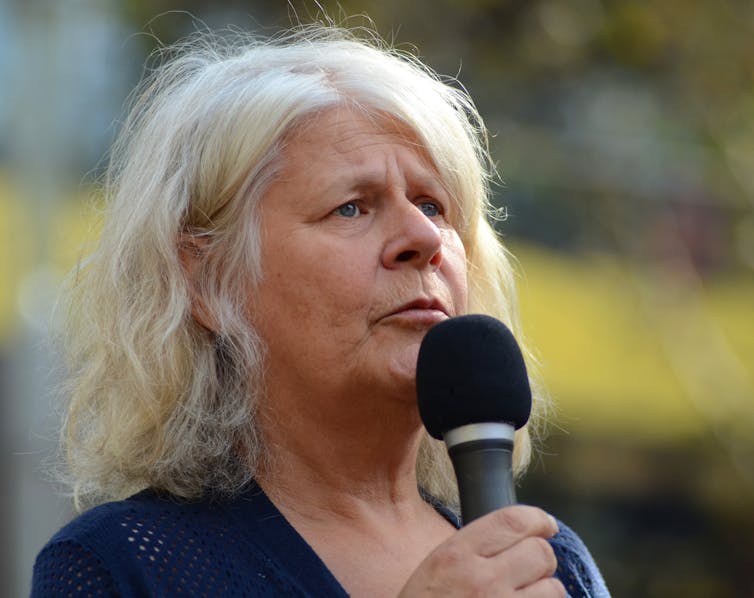Supporting trans people: 3 simple things teachers and researchers can do
How can university teachers support trans students? And what can researchers do to respect trans colleagues? We can start with three simple steps.

How can university teachers support trans students? And what can researchers do to respect trans colleagues? We can start with three simple steps.

Joe Biden made history this month as the first ever US president-elect to thank trans people in his victory speech. During his campaign, Biden promised to end legal discrimination against trans people, which had worsened under Donald Trump.
Globally, trans people are confronted by discrimination and violence, and young trans people experience depression at four times the rate of their peers.
However, while many universities have support services for lesbian, gay and bisexual (LGB) students, trans students often lack tailored support. Comparable data for universities aren’t available, but one Australian study found trans high school students lacking support from teachers are almost four times more likely to drop out than students receiving support.
How can university teachers support trans students? And what can researchers do to respect trans colleagues?
We can start with three simple steps.
Transgender (aka trans) is an umbrella term for various identity categories. Recognising this diversity is a critical starting point.
Read more: We need to count LGBTI communities in the next census – here’s why
Critically evaluating information about trans people is equally important.
Media interest in trans people has soared during the 2000s. Time magazine called 2014 “the transgender tipping point”.
Many of us know of Caitlyn Jenner’s Vanity Fair 2015 cover story and debates over trans people’s access to public bathrooms. Some might also have followed the online “turf war” between trans and cisgender (non-trans) feminists, prompted by J.K. Rowling’s tweets.
Television portrayals of trans people are becoming more diverse and can be educational and entertaining. Some media depictions have even improved attitudes towards trans people.
Read more: Explainer: what does it mean to be ‘cisgender’?
Yet, “any press” isn’t “good press” for transgender people.
Increased visibility brings increased vulnerability. Traditional media often reinforce negative stereotypes, entrenching ridicule, sensationalism and regulation of trans people. Mass media still demean and exploit trans people, reducing the complexity of their lives to a single dominant narrative of “transitioning”.
These misrepresentations are amplified online.
A recent study of 10 million online posts related to transgender issues found more than one in ten contain anti-trans messaging. Over 10% of Twitter comments about being transgender are abusive. Two-thirds of Facebook’s “high-performing content on trans topics” comes from right-leaning and anti-LGBTQ sources.
Academics need to choose our sources carefully. We should also take advantage of high-value opportunities to learn more about trans people’s experiences, such as Trans Awareness Week, November 13-19, and the international Transgender Day of Remembrance, November 20, which commemorates trans lives lost to violence.
With Australian universities facing deep financial problems, new courses are unlikely to be launched for some time. And, with fees for humanities subjects set to double, even students interested in transgender perspectives might not take such a course, if offered.
Including trans content in non-specialist courses is more feasible and impactful.
My forthcoming research shows a required first-year undergraduate research and writing course — taught through the lens of transgender studies — achieved the same learning outcomes as other iterations of the course. But students in the “transgender studies” class also learned about transgender people and their experiences:
[…] the topics discussed in class surrounding transgender people and the community itself was something that I had never really exposed myself to; actually learn and understand the issues that run in society about transgender people and how they face multiple obstacles along the way is very interesting.
Several students reported using this new knowledge outside class:
I am able to provide more insightful, unbiased comments when discussing about the LGBT community outside of class – oftentimes, the comments I use work to defend the community against uneducated people in this area.
Other simple ways educators can “transgender” classes are:
select readings that address trans people’s experiences
mention transgender examples in discussions about diverse topics
use appropriate terminology about sex and gender
invite students to identify their preferred name and pronoun usage.
Cisgender researchers can support transgender colleagues by recognising the ethical and relational aspects of citing their work.

Read more: Penny Whetton: A pioneering climate scientist skilled in the art of life
Although not always apparent on the surface of academic publications, an “ethics of care” characterises the field of trans studies.
First, avoid “outing” trans scholars via pronouns, dead names or other language that might reveal their identity.
Second, consider carefully whether or not to reference trans people’s experiences, to avoid inadvertently exposing them to harm.
Further basic guidelines for research writing are:
use the term “transgender” only as an adjective, without the suffix “ed”
use the acronym “LGBTQ” only when trans people are involved
label all gender identities, not only those of LGBTQ individuals.
Finally, although the grammar buffs among us may hate it, it’s time to embrace the singular “they”. Merriam-Webster’s 2019 Word of the Year is controversial. But the Oxford English Dictionary traces it back to 1375. It has the American Psychological Association stamp of approval.
Read more: For linguists, it was the decade of the pronoun
As one copy editor with The New Yorker explains:
There are these two questions right now about pronouns and one of them is about grammatical number, and the other is gender. […] what I think is that you should call people what they want to be called.
Cisgender university teachers and researchers who take these steps can make a world of difference for our trans students and colleagues.![]()
Katherine (Kate) Power, Lecturer in Management, School of Business, The University of Queensland
This article is republished from The Conversation under a Creative Commons license. Read the original article.

Support We Rep STEM and help us create more content. That includes recruiting and compensating contributors, because we believe everyone should be paid for their work.
